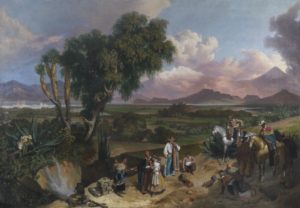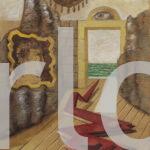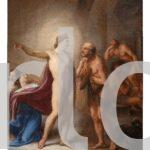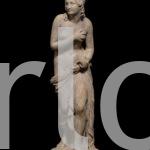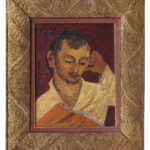| NOT AVAILABLE
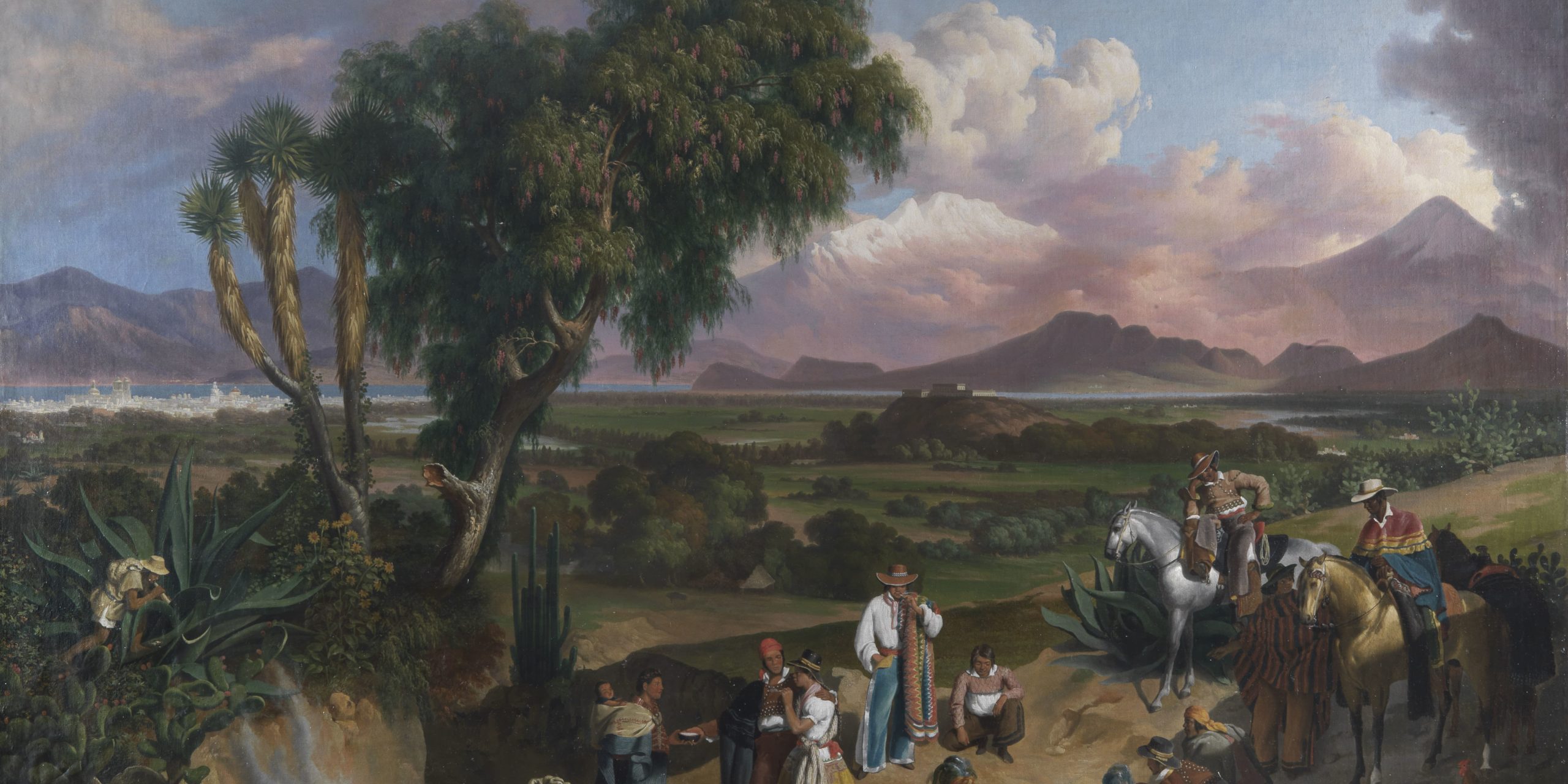
Carlo de Paris
Barcelona 1800-Rome 1861
View of Mexico Valley
1836 ca.
Oil on canvas, 148,5 x 221,5 cm
Provenance: Rome, private collection
After long oblivion, due to the loss of many of the works recorded by the sources of the time, there has been a gradual rediscovery of the figure of Carlo de Paris down to the recent scrutiny of him in the exhibition Roma en México México en Roma, devoted to the fruitful relations between the Rome Accademia di San Luca and the Mexican Academy of San Carlos during the nineteenth century (Camboni 2018). The artistic exchanges between the two institutes went in the 1840s as far as the purchase of works of art done in Rome as exemplary figurative models for Mexican academic teaching purposes and the recruitment in Italy of teachers who travelled to Mexico to graft the renewal of the local figurative culture onto solid classicist and purist bases. The most promising students of the Academy were then sent to Rome to finish off their artistic studies, so that they could then be employed in public projects of embellishment (Sartor 1997, Roma en México 2018). De Paris was a precursor of these relationships and when he reached Mexico in 1828 he was among the first students of the Accademia di San Luca to experience the Americas, after the fundamental venture of Giuseppe Ceracchi, portraitist of the founding fathers of the United States, and in advance of the famous fresco decoration of the Capitol in Washington by Costantino Brumidi.
Mexico could then be considered an entirely novel destination for a painter. De Paris went there accompanied by his brother Gaetano, a theatre and opera impresario, who formed a company of singers signed up from Italy under the direction of Filippo Galli (Galí Boadella 2002, pp. 301-302), an esteemed interpreter of Rossini, staging performances in the Coliseo de México that the painter himself was to help decorate.
Carlo de Paris was born in Barcelona of an Aragonese father and a Roman mother, and after the death of his parents was directed by his tutor Giovan Francesco Masdeu to an apprenticeship in art, first under the Spanish painter Josè Aparicio, then with Luigi Agricola. At the Accademia di San Luca he was taught by Gaspare Landi, finishing second in the Canova competition with the Continence of Scipio (Rome, Accademia Nazionale di San Luca) and specializing in the genre of history painting, both classic and romantic, even during a stay in Milan.
Upon his arrival in Mexico City, de Paris was subjected to an on-the-spot test of painting from life by the members of the Academia de San Carlos wanting evidence that he was the creator of the portfolio he had brought from Europe. He passed with a painting on a Roman subject, The Pontifical Chapel in the Palace of the Quirinal with a papal service, which was followed by a commission from the Philippine Fathers of a large apse tempera of Calvary. In the odd and lively autobiographical sketch, published posthumously by Francesco Gasparoni in 1863, de Paris describes successive commissions of portraits and history paintings, in which he consciously attempted to adapt to the taste of the country. The great painting of modern history depicting the Surrender of the Spanish division commanded by General Barradas in the province of Tampico (Mexico City, Museo Nacional de Historia “Castillo de Chapultepec”) was checked for iconographic accuracy as he painted by the aides of General Antonio López de Santa Anna, of whom he made a portrait (Mexico City, Museo de Historia de la Ciudad), and was intended for the General Congress chamber. He was then commissioned to make portraits of all the presidents of the republic, Victoria, Guerrero, Pedrasa, Vice-President Gomez Farias and Agostino Iturbide, who had the honour of being hung in the Municipal Hall (Mazio 1845, 163). Recalling the style adopted in his portraits, de Paris set down to his memoir a piece of information that throws light on the formal methods of a great deal of Spanish-American art of the period: he confesses to painting them “almost without shadows, because some clients complained, saying they have not tinted faces ” (de Paris 1863, p.336).
In those years de Paris made many journeys across the vast country “drawing the various different garments of the natives and painting many views of those regions most interesting for landscape paintings, always varying the nature of the places and vegetation, depending on the height above sea level” (de Paris 1863, p. 336). The result of those wanderings, apart from a museum of natural history and archaeology, was an album of 100 drawings of figures and landscape and others with the usages and traditions of Mexico that he brought back to Rome in 1836, proposing to publish them as lithographics. This graphic material was the basis of the Mexican paintings done in the following years, the “historical landscapes“, a genre in which his friend Massimo D’Azeglio excelled, the grandiose views described in the newspaper Il Saggiatore in which he set the events of the Spanish conquest (Mazio 1844). With these works de Paris alternated views of Rome, romantic historical subject matter and that of contemporary history, from the series devoted to the revolutionary events in Rome in 1848-49, to the celebratory paintings of the pontificate of Pius IX, like the Return of Pius IX to Rome on 12 April 1850 (Vatican City, Museo Storico, Palazzo Lateranense) and the Proclamation of the Dogma of the Immaculate Conception (Rome, Fondazione Roma).
Among the rare Mexican views painted by de Paris that have so far re-emerged, one can include the View of the Plaza Major of Mexico City (1853, Mexico City, Franz Mayer Museum, Mexico 1994, pp. 40, 116-17), that of the Pico de Orizaba, and Citlaltépetl (1853, Mexico City, private collection on deposit at the Fomento Cultural del Banco Nacional de México, cf. S. Grandesso, in A Picture Gallery 2012, pp. 84-87; S. Grandesso, in Roma en México 2018, pp. 255-257) and the View of the Valley of Mexico held by the Pantheon (Rome, Pontificia Insigne Accademia di Belle Arti e Lettere dei Virtuosi al Pantheon, cf. M. Gianfranceschi, in Tiberia 2016, pp. 184-187) .
It is known that the work, dated 1835, was done on the spot by the artist who for this purpose spent several months in a building dominating the valley (cf. the minutes of the Virtuosi al Pantheon for 1862, cited in M. Gianfranceschi, in Tiberia 2016, page 185). In his memoir de Paris speaks of the painting as follows: “I did a picture about 10 handspans by 7, where I did the view of the valley of Mexico taken from the heights or hills that lie to the west of said valley. When I had finished, there was no lack of offers of sums of some consideration if I wanted to be rid of it, but since I was soon to leave for Europe, I did not want to get rid of such a work, especially since I had painted it with the idea of taking it to Rome, and keeping it in memory of a country where I had been so well received by its excellent inhabitants” (de Paris 1863, pp. 401-402). Matched against that prototype, bequeathed to the Accademia dei Virtuosi al Pantheon, to which he had belonged, the unpublished version presented here must have been painted by de Paris shortly after his return to Rome, probably at the request of a client.
The view is a rare and perhaps unique testimony to the appearance then of the Mexican capital, still in the 1830s surrounded by water. But even within the landscape tradition of Mexican painting, it has the importance of an incunabulum, well in advance of the famous views by the Piedmontese Eugenio Landesio, who arrived there from Rome in 1855 to teach at the Academy, and his pupil José Maria Velasco.
“The Valley of Mexico is portrayed by him at that time of day since, it having poured down as usual in the summer there, in the afternoon hours the sky clears, taking on a red tint, as we see an Aurora Boreal barely coloured”, as a contemporary commentator explained (Checchetelli 1839, p. 174). The grandiose vision lit by strong colours, ample enough to take in the capital seen from afar and the imposing volcanic cordillera surrounding it, enriched by the show of the native growths and the appearance and customs of the local populations, demonstrates the artist’s interests in the sublime of the American landscape and in the ethnographic documentation of its inhabitants. As the contemporary critic Paolo Mazio recorded, “an overwhelming passion ruled de Paris, that of studying nature and the customs of Mexico on the spot. Nature is huge here as in all other parts of American soil: immense plains, savannahs as the Spaniards say or boundless prairies, lakes, when open when surrounded by forests, which look like oceans […]; add immense rivers […], forests in which the vegetation reaches the peak of its strength, and then volcanoes, cliffs, mountains from which open large and magnificent stretches of land and sea”. And he concluded by recalling this view: “The last work he made in America was the general view of the Valley of México with various figures showing some of the country manners of that province” (Mazio 1845, pp. 164-165).
The literary description of the Valley of Mexico set down by the painter himself in his autobiography also seems a comment on the painting: “The Valley of Mexico, or, as the old people say, of Anahuac, is the most beautiful and most picturesque of all those deserving attention in the whole realm. Surrounded by mountains, the majority of porphyry, it opens for about 34 miles at its largest diameter, 18 at the smaller, and just over one hundred in the periphery, forming an elliptical basin on the great plateau of Anahuac, 8,227 feet above sea level. It is irrigated by various springs of mineral water that flow from the innards of the many adjacent volcanoes, which, although long since extinct or at least dormant, also show inside copious and obvious traces of ancient repeated eruptions” (de Paris 1863, p 263). He then described the different lakes, Tzopango, Xaltouan, Tetzeoco and the lagoon of Chalco, and the tradition of cultivating floating gardens, which daily supplied fresh vegetables to the capital. The hill surmounted by a building in the centre of the painting was then mentioned as follows: “In the western part of the said valley, and entirely isolated from the other mountains, the little Chapultepec rises about a couple of miles from the city. A magnificent wood of splendid trees (called by the Spanish sabinos, and by the naturalists Cupressus sempervirens) covers the plain inside the mount. Here the Mexican emperors had their sport, and especially their hunting reserve. There on the flat atop the mountain a palace built by the Conte di Galves viceroy of Spain is now very broken down”. On the left stands the noble City of Mexico, surrounded by lakes now drained, while the presence on the right of the snow-covered jagged peak of Iztaccíhuatl and the majestic cone of Popocatepetl, enabled the artist to recall in his memoir the adventurous nocturnal ascent to the crater of the second volcano, forbidden to men according to the ancient beliefs of the natives (de Paris 1863, pp. 319-321).
To give the scale of the vastness of the view, in the foreground of the painting de Paris set a sample of Mexican flora, the monumental cypress of Montezuma, or taxodium mucronatum, the yucca tree and the agave salmiana. A native Mexican is busy collecting the sap, through a perforated bullhorn, for the fermentation in the bladder next to the tortillas the famous pulque, which his wife is offering to a pair of Creoles. Behind them, as documentation of a local custom, various local inhabitants, rendered with the curiosity of the ethnographer with a taste for the exotically picturesque in physiognomy and clothing, are intent on following and inciting a cockfight.
Stefano Grandesso
Camboni 2018
E. Camboni, Carlo de Paris: Roma-Messico a/r, in Roma en México México en Roma. Las academias de arte entre Europa y el Nuevo Mundo 1843-1867, editado por G. Capitelli y S. Cracolici, Roma 2018, p. 95-110.
Roma en México 2018
Roma en México México en Roma. Las academias de arte entre Europa y el Nuevo Mundo 1843-1867, editado por G. Capitelli y S. Cracolici, Roma 2018
A Picture Gallery 2012
A Picture Gallery in the Italian Tradition of Quadreria (1750-1850), exhibition catalogue, New York, Sperone Westwater Gallery (2013), in collaboration with Galleria Carlo Virgilio & Co., edited by S. Grandesso, Rome 2012.
Tiberia 2016
V. Tiberia, La collezione della Pontificia Insigne Accademia di Belle Arti e Lettere dei Virtuosi al Pantheon. Dipinti e sculture, catalogue edited by A. Capriotti, P. Castellani, Rome 2016.
Checchetelli 1839
G. Cecchetelli, “Rivista di alcuni studi di belle arti in Roma. Giornata III”, in Il Tiberino, n. 44, 1839, pp. 173-174.
de Paris 1863
de Paris, Carlo, “Vita del pittore Carlo De Paris scritta da lui stesso, Arti e Lettere. Scritti raccolti da Francesco Gasparoni, I, 1863, XVI, pgs. 253-255; XVII, 259-264; XX, 318-321; XXI, 335-336; XXII, 350-352; XXIII, 364-365; XXV, 397-401.
Galí Boadella 2002
Galí Boadella, Montserrat, Historias del Bello Sexo. La introducción del Romanticismo en México, México 2002.
Mazio 1844
Mazio, Paolo, “Alcuni paesi del Messico dipinti da Carlo De Paris”, Il Saggiatore, A. I, vol. II, Rome 1844, pgs. 210- 213.
Mazio 1845
Mazio, Paolo, “Il passaggio del Mar Rosso dipinto di Carlo De Paris, e il suo studio”, Il Saggiatore, A. II, vol. III, Rome 1845, pgs. 162-167.
Mexico 1994
Mexico: a landscape rivisited, exhibition catalogue, Smithsonian Institute, 1994.
Sartor 1997
Sartor, Mario, “Le relazioni fruttose. Arte ed artisti italiani nell’Accademia di San Carlos di Messico”, Ricerche di Storia dell’Arte. Artisti italiani in America latina. Presenze, contatti, commerci, 63, 1997, pgs. 7-33.
The Carlo Virgilio & C. Gallery searches for works by de Paris Carlo (1800-1861)
To buy or sell works by de Paris Carlo (1800-1861) or to request free estimates and evaluations
mail info@carlovirgilio.co.uk
whatsapp +39 3382427650
